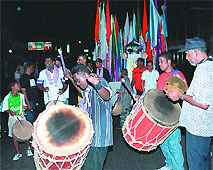



FLASHBACK of Hosay flagnight in St James last
year.
Photo: KENROY AMBRIS
Small tadjahs show tonight
Apr 02, 2001
RESIDENTS and visitors to St James and Cedros will tonight witness the second phase of the annual four-day Shi’ite Muslim commemoration of the siege and slaughter of Imam Hussain and his followers.
Observances began last night, with the memory of a fallen soldier and his significance to Islam and tomorrow night, huge and ornate replicas of the tombs in which the remains of Hussain and his brother Hassan were buried will be pulled through the streets.
Tonight, devotees remember the plight of the children caught in the siege and who starved to death or were slaughtered along with their parents. These events took place in what is now Iraq in 640 AD.
The story is one that tugs at the heart, particularly in those sequences where soldiers under instruction to dismantle Islam and wipe out its followers, disregarded pleas made on behalf of the children.
Small Hosay, as tonight’s commemoration is called, present small tadjahs, representative of the resting places of the murdered children. Imam Hussein’s six-month-old son, Ali Ashgar, was one of those children.
Muslim scholars say the Imam picked up the baby to take him to the front, so that he could demonstrate to the soldiers who had them under siege that the child was dying of thirst. The move seemed to have tugged at some sensitive chords among some of the soldiers who, the story goes, began to cry at seeing the parched lips of Ali Ashgar.
The Imam held up the baby and asked “What has this child done to you?” But his cry clearly did not impress the opposing army’s generals, one of whom, Omar Bin Saadm, decided to take no chances and ordered his best archer, Hurmala, to kill the child. The other children in the Imam’s group were starved to death.
Each night, the procession begins about 11 p.m. and often goes into the wee hours of the following morning. On Wednesday in St James (Thursday in Cedros) a day procession is staged. At every sequence, the cortege moves to the beat of tassa bands.
Using a combination of heavy thud of the dhol, tinkling of cymbals and rhythmic rolling of the tassa, the bands could be heard for miles as early morning replaces late night, a fact that introduces a conflict of purposes between spectators and devotees.
Because the same combination of drums is used in festive applications, well-oiled tassa groups often hold quite another persuasion for the thousands of spectators, many of whom remain unfamiliar with the religious root of the commemoration.
Any problems with this page? Contact our webmaster. This site is designed and maintained by S.E.L.F..
Copyright © 2000 - 2001 Terry-J